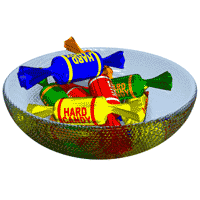Sponsored by BoysStuff.co.uk


How to make homemade sweets
Fancy doing something different this weekend? Why not make your own traditional sweeties. Whether you are a beginner or an old hand in the kitchen our tips, tricks and recipes will help to get you started.
Sweetie Ingredients
As with any type of cooking there are factors that affect the taste of your Sweets:
1. The ingredients that you use
2. The procedure that you follow
Always use quality ingredients and where possible use natural flavourings and colours to ensure successful, delicious Sweeties.
Sugar boilings consist of two main ingredients: sugar and flavourings. Sugar is the basic raw material. No special sugar is required during the sweetie making process; you can simply use sugar from your kitchen cupboard.
Equipment for Making Sweeties
In general, Sweetie making does not require much specialist equipment. Sweeties can easily be made using basic kitchen tools that are to hand. A Sweetie thermometer is the most commonly used tool during the making of sweets. These are relatively cheap and easy to get hold of. A metal spatula or scraper will also be required to manipulate the sweetie mixture during the final stages of making the sweets.
Working with Sugar
Making sweets is a relatively simple process. To make the Sweeties, the main ingredients need to be boiled to a specific temperature. The texture of the finished sweet depends on the temperature that the sugar is boiled to. The higher the temperature is during boiling; the harder the texture of the sweets. Thus to make traditional boiling or humbugs a high temperature is used, but to make toffees and fudges a lower temperature is used.
To ensure that there is no moisture in traditional Sweeties they need to be "pulled". Pulling Sweeties is done by hand and can take a little practice to perfect. Some Sweetie manufacturers tend to use vacuum machines to do this now, however most Traditional sweet makers still pull by hand. Pulling the sweets also changes the texture of the sweetie mixture, making it appear shinier.
Basic Strawberries and Cream Sweetie Recipe
If you are ready to make some sweeties a basic recipe is:
Please note that boiling sugar can cause serious burns if it splashes onto skin. Children should be supervised by an adult if making these recipes.
450g/1lb Granulated Sugar
150ml/1/4 pint water
A pinch of cream of tartar
Strawberry Essence and Red Food Colouring
Combine these ingredients in a large saucepan over medium heat and stir until the sugar dissolves.
Allow the sweetie mixture to continue to cook, without stirring, until it reaches Hard-crack stage (148 degrees Centigrade). Once the sweets mixture has reached the desired temperature, remove from the heat and set aside for a few minutes to cool.
Spoon half the mixture onto a cool oiled surface. A marble or heat safe board will suffice.
At this stage put the remaining half of the mixture, that will not be worked with immediately, onto a baking sheet and place in a 200 degree oven to remain warm and pliable.
For this recipe, ½ tsp of Strawberry flavoured extract and 3-4 drops of red food colouring should be sufficient. With a metal spatula, begin to work the sweetie mixture. This is best done by folding the edges into the centre. At this point add the flavouring and colour and continue turning and working the mixture until it is just cool enough to handle.
To begin pulling the sweetie mixture, lift it from the work surface with the spatula and mould it into a cylinder shape. Now stretch it out between your hands.
Bring the mixture back together and again stretch it out between your hands. Repeat until the mixture begins to hold its shape when stretched out and reaches the desired length.
Set aside and remove the second batch of mixture from the oven. Repeat the steps above but do not add the essence or colour.
When the two lengths of sweetie mixture are made, gently start to twist together. You should now be left with a multi-coloured length, of what can best be described as rope.
Now, using a pair of oiled kitchen scissors cut the sweetie rope into short pieces of equal size and allow them to dry and harden completely at room temperature.
Store in a cool, dry place.

| © RIYAN Productions |

